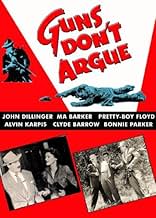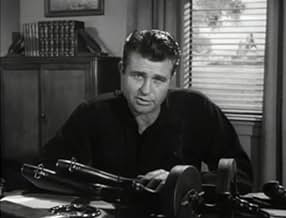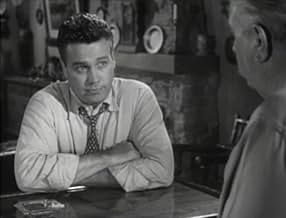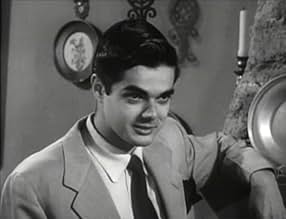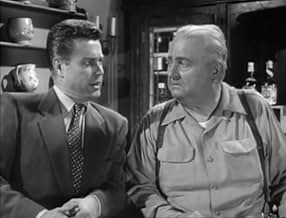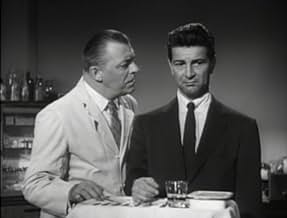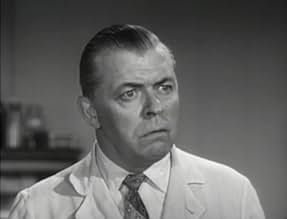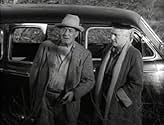Añade un argumento en tu idiomaA composite of three re-edited episodes from the 1952 TV series, Gangbusters, released to theatres in 1957 as a feature film. Gang Busters (1954) was a similar effort.A composite of three re-edited episodes from the 1952 TV series, Gangbusters, released to theatres in 1957 as a feature film. Gang Busters (1954) was a similar effort.A composite of three re-edited episodes from the 1952 TV series, Gangbusters, released to theatres in 1957 as a feature film. Gang Busters (1954) was a similar effort.
- Dirección
- Guión
- Reparto principal
Baynes Barron
- Clyde Barrow
- (as Baynes Baron)
Lash La Rue
- 'Doc' Barker
- (as Lash Larue)
Reseñas destacadas
Dizzy, Dumb, and Downright Inaccurate with just about Everything. Where to Start? Why does IMDb put a Date of 1960 on the Thing and then in the Synopsis say it was "released to theaters in 1957"?
The 1950's were Ripe with Pro-Govt Propaganda from the Very Start of the Conservative Decade. Government Agencies, Law-Enforcement, Hell even the "Dog Catcher" could do No Wrong. It was an attempt to "Control" the Population, Shut-Up, Don't Ask Questions, Toe the Line, and be Good Consumers, No Worries, Big Brother is "Looking Out for You".
For the Most Part...It Worked.
"Gangbusters" was Produced for TV in 1952, this is a Compilation of Episodes Released to Movie Theaters in 1957. It is Riddled with Ridiculous Didactics, Smug, and Condescending. A Product of its Era. With Ed Wood Like Acting and Editing, the Film is Disorienting as it Clunks its way through every "Headliner" of Thirties "Gangsterdom".
Most of the Budget was probably Spent on "Tommy Guns" and Bullet Drums. It's pretty Bad even for Early TV. Kids of the Day Enjoyed it as Entertainment, but for Adults it's as Low-Brow as it gets. There are even a few Scenes that Reek of Exploitation with Pistols in the Garter-Belt and Extremely Tight Sweaters and Skirts.
What a Hoot!
Note...Good title though.
The 1950's were Ripe with Pro-Govt Propaganda from the Very Start of the Conservative Decade. Government Agencies, Law-Enforcement, Hell even the "Dog Catcher" could do No Wrong. It was an attempt to "Control" the Population, Shut-Up, Don't Ask Questions, Toe the Line, and be Good Consumers, No Worries, Big Brother is "Looking Out for You".
For the Most Part...It Worked.
"Gangbusters" was Produced for TV in 1952, this is a Compilation of Episodes Released to Movie Theaters in 1957. It is Riddled with Ridiculous Didactics, Smug, and Condescending. A Product of its Era. With Ed Wood Like Acting and Editing, the Film is Disorienting as it Clunks its way through every "Headliner" of Thirties "Gangsterdom".
Most of the Budget was probably Spent on "Tommy Guns" and Bullet Drums. It's pretty Bad even for Early TV. Kids of the Day Enjoyed it as Entertainment, but for Adults it's as Low-Brow as it gets. There are even a few Scenes that Reek of Exploitation with Pistols in the Garter-Belt and Extremely Tight Sweaters and Skirts.
What a Hoot!
Note...Good title though.
Apparently re-cut episodes from the Gangbusters TV show on the big screen. While this was frequently done in the 50's and 60's because people didn't have a TV or a color TV and producers wanted an increased return on their investment (big screen ticket sales or if it went to the small screen resale of a series that isn't in syndication), the results were usually less then the sum of their parts. The only time I've ever seen it work were where multi-part stories were put together (Ala Rocky Jones or Man From Uncle) or in the case of horror anthology (The Veil and 13 Demon Street). Here the effect is to have stories of American criminals in the 20's and 30's (Dillinger, Pretty Boy Floyd, Bonnie and Clyde, etc)inter-cut with each other as a narrator talks about how the FBI hunted them down. Its a weird concoction that doesn't quite work because its clear that there are things here that don't belong together. More than once I looked at the TV oddly because things didn't seem right. In fairness I won't describe the cheapness of the production since this was what early TV (and the series) was like. Its not bad, but its not very good either. To be perfectly honest the episodes of the series that I've seen work better a single episodes where we're not expecting as much. Given the choice I'd rent dvds of the show instead of this movie.
The history of early-twentieth-century organized crime, and the response of law enforcement, narrated on the budget of a high-school sex-ed movie. Martin Scorsese recommended this movie as the ultimate exemplar of visual storytelling on a well-worn shoestring, and he knows whereof he speaks: even Sam Fuller never had to portray a shooting death by dissolving to stock footage of a firing gun.
This feature-length movie has been edited from episodes of the 1952 TV series, Gangbusters. The style is government informative shorts presented by police agents and promoting their exploits. It dramatizes various gang crews and their ultimate downfalls. Some of the famous names include Pretty-Boy Floyd, Bonnie and Clyde, John Dillinger, and Ma Barker.
In a way, this is an interesting look into early television. As a movie, it is little vignettes that don't gel together. Sure, I remember the shootout with the Barkers. Maybe the final Bonnie and Clyde shootout helps informed the later movie. Far more often, this is a weak production of disjointed scenes and I don't know the vast majority of these actors. The constant changing of the characters do not help.
In a way, this is an interesting look into early television. As a movie, it is little vignettes that don't gel together. Sure, I remember the shootout with the Barkers. Maybe the final Bonnie and Clyde shootout helps informed the later movie. Far more often, this is a weak production of disjointed scenes and I don't know the vast majority of these actors. The constant changing of the characters do not help.
`Guns Don't Argue' is essentially a docu-drama about the war against crime in the 20's and 30's, with particular emphasis on the role of the FBI in that process. It is very much pro-Hoover, pro-law-enforcement, and anti-criminal, and is also quite heavy-handed (often laughably so) in its narration and its portrayals of the criminal element. While offering an interesting counter-point to such romanticisations of the outlaw as Arthur Penn's `Bonnie and Clyde', this movie simply goes TOO far in the opposite direction, to the detriment of what real history it presents.
The worst revisionist moments are in the portrayals of the executions of John Dillinger and of Bonnie and Clyde (interestingly, consistently called `Clyde and Bonnie' in this picture). In reality, each was gunned down maliciously by lawmen who gave no warnings, having set up fool-proof ambushes and using patsies to bait their prey. The vigillantism of law enforcement officials in these days is a legacy America still must live down. In `Guns Don't Argue,' however, Bonnie, Clyde and Dillinger are somehow able to get off the first shots, and the implication is presented that they were given ample opportunity to surrender. Also notably lacking is any sense of the popularity of bank robbers among the American masses, especially after the stock market crash. Dillinger, particularly, was regarded with considerable reverence in the 30's, not the abject fear that this film suggests.
In another interesting twist on history (although a more informed criminal historian will have to bring out the true story), Lyle Talbot takes on a role out of Ed Wood's `Jail Bait' (1954) and is forced to perform plastic surgery on gangster Al Karpis at gunpoint. Those who have seen Ed's original will agree - his `surprise ending' was more effective than this rip-off's.
The best sequence of this movie, however, is that of the vicious `Ma' Barker' and her brood. The little old lady with a Tommy-gun is somehow the most powerful image of the film. The film is quick to point out that the only reason Barker's family attended church was because it helped them avoid jail sentences, of course. Ma' does spend a good deal of screen time in the kitchen, however, reminding us that 50's values cross race, class and even legal lines.
The worst revisionist moments are in the portrayals of the executions of John Dillinger and of Bonnie and Clyde (interestingly, consistently called `Clyde and Bonnie' in this picture). In reality, each was gunned down maliciously by lawmen who gave no warnings, having set up fool-proof ambushes and using patsies to bait their prey. The vigillantism of law enforcement officials in these days is a legacy America still must live down. In `Guns Don't Argue,' however, Bonnie, Clyde and Dillinger are somehow able to get off the first shots, and the implication is presented that they were given ample opportunity to surrender. Also notably lacking is any sense of the popularity of bank robbers among the American masses, especially after the stock market crash. Dillinger, particularly, was regarded with considerable reverence in the 30's, not the abject fear that this film suggests.
In another interesting twist on history (although a more informed criminal historian will have to bring out the true story), Lyle Talbot takes on a role out of Ed Wood's `Jail Bait' (1954) and is forced to perform plastic surgery on gangster Al Karpis at gunpoint. Those who have seen Ed's original will agree - his `surprise ending' was more effective than this rip-off's.
The best sequence of this movie, however, is that of the vicious `Ma' Barker' and her brood. The little old lady with a Tommy-gun is somehow the most powerful image of the film. The film is quick to point out that the only reason Barker's family attended church was because it helped them avoid jail sentences, of course. Ma' does spend a good deal of screen time in the kitchen, however, reminding us that 50's values cross race, class and even legal lines.
¿Sabías que...?
- CuriosidadesAs usual for bottom of the barrel 1950's re-enactments, clothing. furniture, and even automobiles are strictly late 1940s/early 1950s vintage, not 1920s and 1930s especially in the Kansas City Massacre, although the names of notorious gangsters killed in the 1930s, such as Clyde Barrow, Bonnie Parker and Pretty Boy Floyd are tossed around like confetti.
- PifiasThough set in the 1930s, the film's sets, costumes and many of the cars seen in it are all from the 1950s.
- ConexionesEdited from Gang Busters (1952)
Selecciones populares
Inicia sesión para calificar y añadir a tu lista para recibir recomendaciones personalizadas
Detalles
- Fecha de lanzamiento
- País de origen
- Idioma
- Títulos en diferentes países
- Guns Don't Argue!
- Localizaciones del rodaje
- Pacific Ave & Windward Ave, Venice, Los Ángeles, California, Estados Unidos(as Beverly Dr & 38th St, Sioux Falls)
- Empresa productora
- Ver más compañías en los créditos en IMDbPro
- Duración
- 1h 32min(92 min)
- Color
- Mezcla de sonido
- Relación de aspecto
- 1.37 : 1
Contribuir a esta página
Sugerir un cambio o añadir el contenido que falta

